Published June 20, 2023
- Home
- Conservatory Cultivators
- Summertime Magic and Whimsy Await at the Paul Busse Garden Railway
Published June 20, 2023
If you’ve ever visited the Conservatory and enjoyed watching the G scale model trains wind their way along 1,122 feet of track through a miniature landscape, you have the team of dreamers at Applied Imagination to thank. Now headed up by second-generation owner Laura Busse, this dynamic company of artisans is responsible for some of the most elaborate garden railways in the nation. From the United States Botanic Garden in Washington, D.C. to the Biltmore Estate in Asheville, North Carolina, their transporting train scenes get kids excited and make adults feel like kids again.
We sat down with Laura to learn more about how they’re made and cared for, and we chatted with Deb Sweet, an incredible donor who helped us make this exhibition part of our permanent collection in perpetuity. Read on for more about how the garden railway is gearing up to bring another fabulous season of magic and whimsy to Columbus this summer!
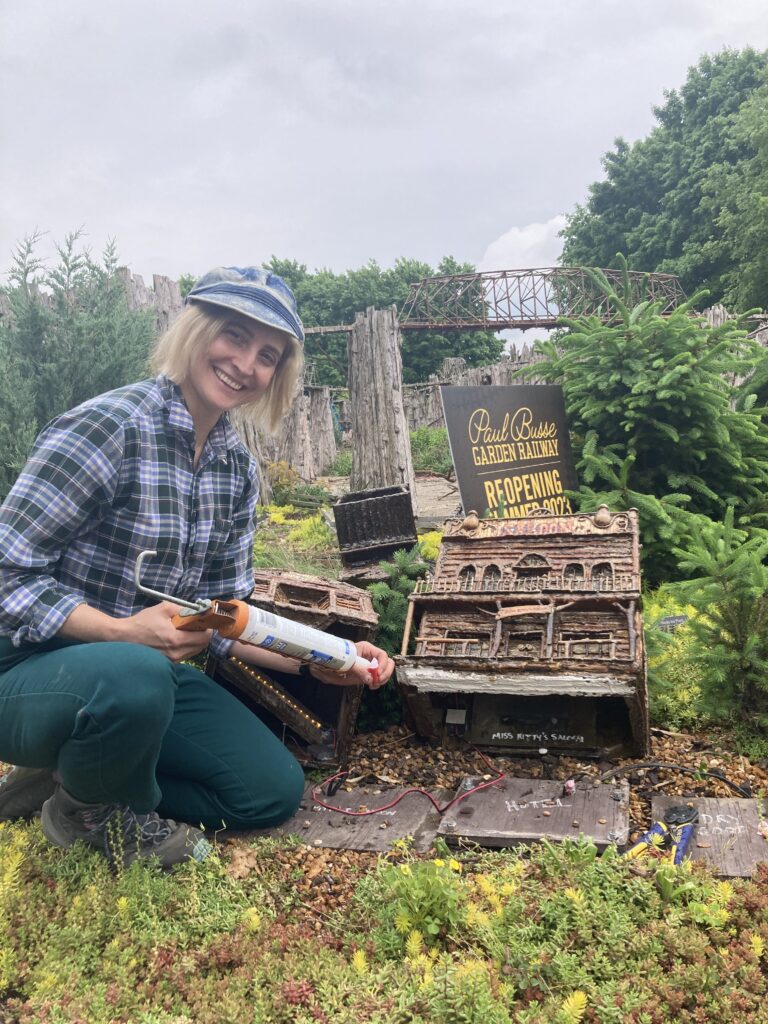 Laura Busse
Laura Busse
On a drizzly May afternoon, we sat down with Laura as her team worked to clean and true the train tracks and position the recently-refreshed miniature houses ahead of the exhibition reopening on June 3rd. Laura, dressed in a jaunty canvas conductor-style cap, was ready to share all about her background and Applied Imagination’s future. She got her start building models at a basement workbench under the tutelage of other artisans, working under the leadership of her dad and Applied Imagination founder, Paul Busse.
The buildings in the Conservatory collection were first created in 1992 as part of the Ameriflora international horticulture exhibition, and have been on display annually since. Each year, the brass flex track needs to be tightened and repaired, the little metal wheels on the G scale trains need to be cared for and replaced as needed, and the miniature houses need to be readied for the coming season. “We come in February and pick up the entire collection and bring them back” to their workshop in Alexandria, Kentucky. There, the structures “get washed, dried and repaired with anything that needs replacing. Once it’s fixed up, it gets a new UV coating. They require maintenance just like the train tracks,” Laura explained.
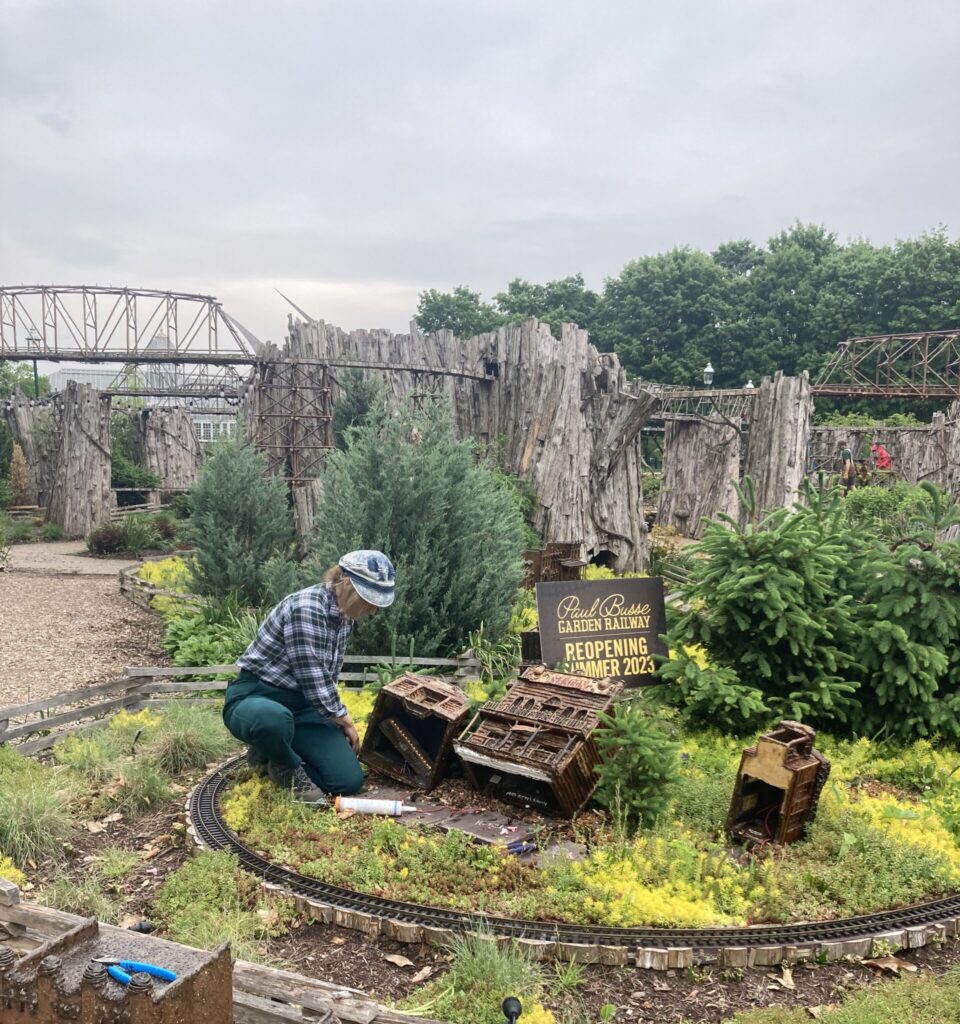 Laura Busse
Laura Busse
All the highly-detailed models are lovingly constructed, taking anywhere from 80 to 800 hours. The biggest one to date, a scale replica of the Biltmore Estate, took over 3,000 hours. “They take incredible patience,” Laura said. Not just patience, but immense creativity. All of the models are made of natural materials, built atop a Gatorfoam base, affixed with industrial adhesive, and coated in spar urethane or resin for longevity.
“You look at natural material and how it can mirror architecture,” she explained. “An old artist who worked for us used to say ‘the forest looks at you differently’” after you become a craftsperson with Applied Imagination. Although they are painstakingly crafted, “we want a viewer to be able to point at it and see that it looks like natural materials.”
Laura estimates that the Conservatory collection has 500 distinct natural materials included as part of the overall garden railway. “Brickwork can be made from bark. Pinecone scales are commonly used for roof shingles and decoration around windows. Branches become window mullions. We use all kinds of seed pods. We love gourds for domes and toppers, and we love grapevine tendrils to create whimsical ironworks and magic around the porches of certain houses. We love our walnuts and peach pits,” which vary in appearance and patterning depending on how they’re cut.
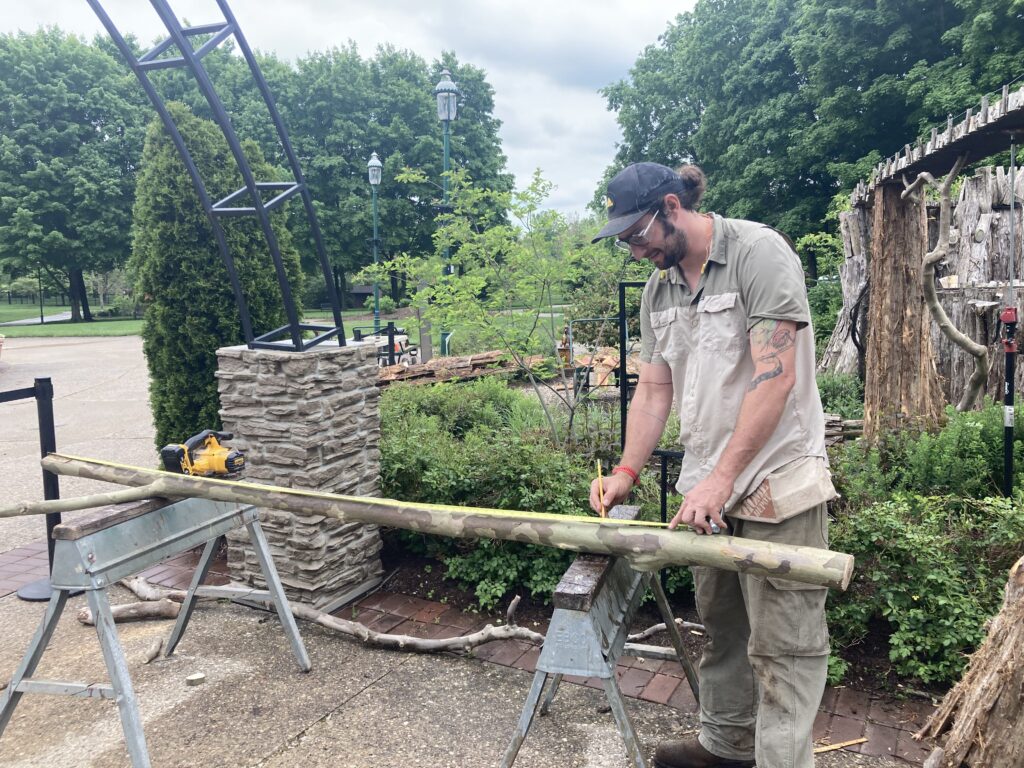 Applied Imagination Worker
Applied Imagination Worker
“We buy the cedar offcuts from a mill that would otherwise be wasted. The bark offcuts allow us to create architectural forms. The willow we use for bridges and trusses is a willow that grows in wet soil near our workshop.” One thing they can’t use to build the models? “Anything edible. Even if it’s polyurethaned, little creatures will come and eat it.”
Applied Imagination got its start in garden railways when Laura’s father was a landscaper. In 1975, Paul discovered the brand LGB’s new G-Scale model trains, which ran both indoors and out. His first train layout was installed in a friend’s hobby store, garnering local press for the store and for Paul’s landscape company. At the request of then Ohio Governor, Jim Rhodes, Paul created his first public garden railroad for the Ohio State Fair in 1982.
“Typically, garden railways have little plastic buildings that go along with the display. He felt those were not elevated enough…” so the idea of freeform, architectural models made of natural materials was born. “Now, fast forward 32 plus years, we have had three decades of artisans that have handed down their techniques and have continued to evolve what these could be.”
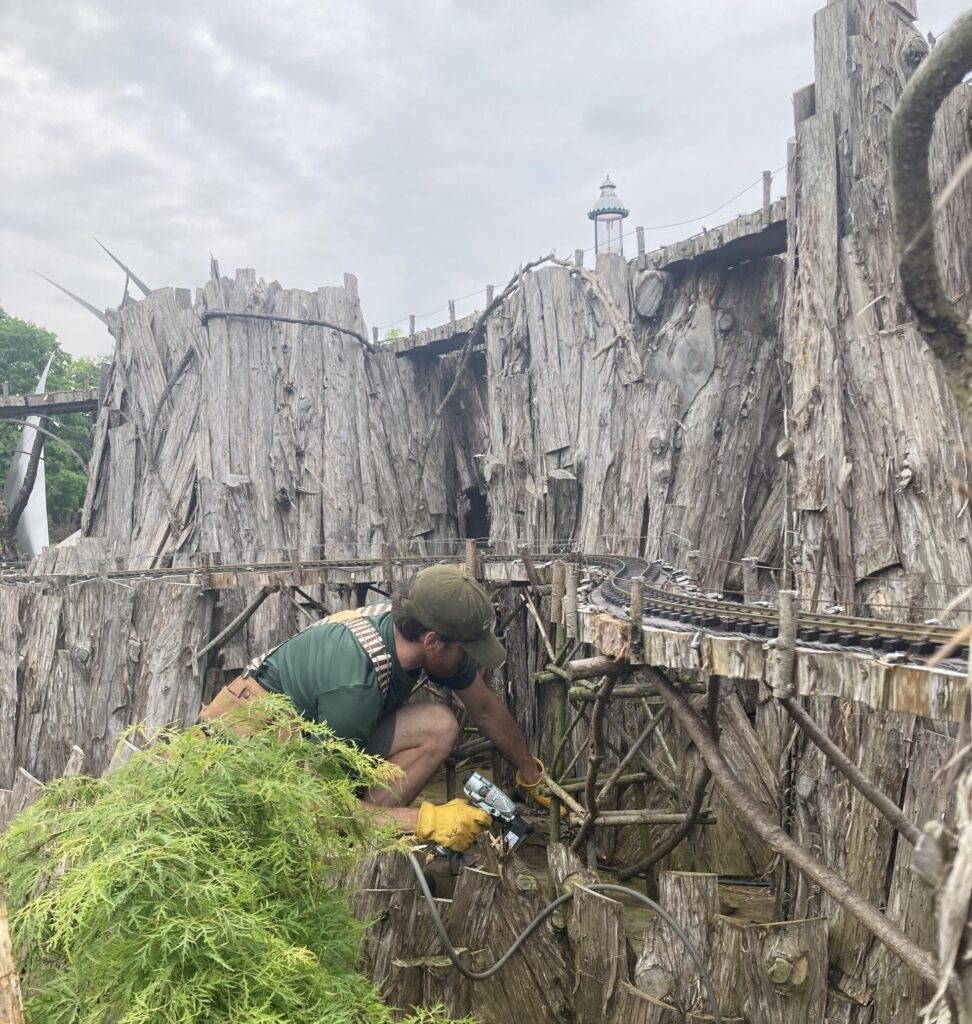 Applied Imagination Worker
Applied Imagination Worker
“We’re always trying to challenge ourselves,” said Laura. “Paul liked to say in response to ‘what’s your favorite project?’ He’d say ‘the next one.’ That’s the spirit, it keeps our imaginations fed and keeps us pushing the boundaries of what botanical art is.”
The exhibition is supported by “a whole force of people from exhibition to maintenance to volunteers, and all the day to day operations that go on to keep this functioning,” said Laura. “Trees may have shed debris on the tracks, the tracks need to be cleaned, the brass will develop a coating that prevents it from being conductive–there’s a lot that goes on” which requires daily care and maintenance by Conservatory staff and volunteers. “It takes a village,” said Laura.
Part of the village over the years has included partners and donors like John F. Wolfe and the Wolfe Family, Huntington Bank, and Columbus Garden Railway Society, a group that has been instrumental in making the garden railway such a success. One member, Deb Sweet, has been a fixture at the railway for the last few seasons. She is joined by others from her club of model train enthusiasts such as Ron Mayer, a supporter who holds the record for the most volunteer hours, all working together to help keep the exhibition on the rails!
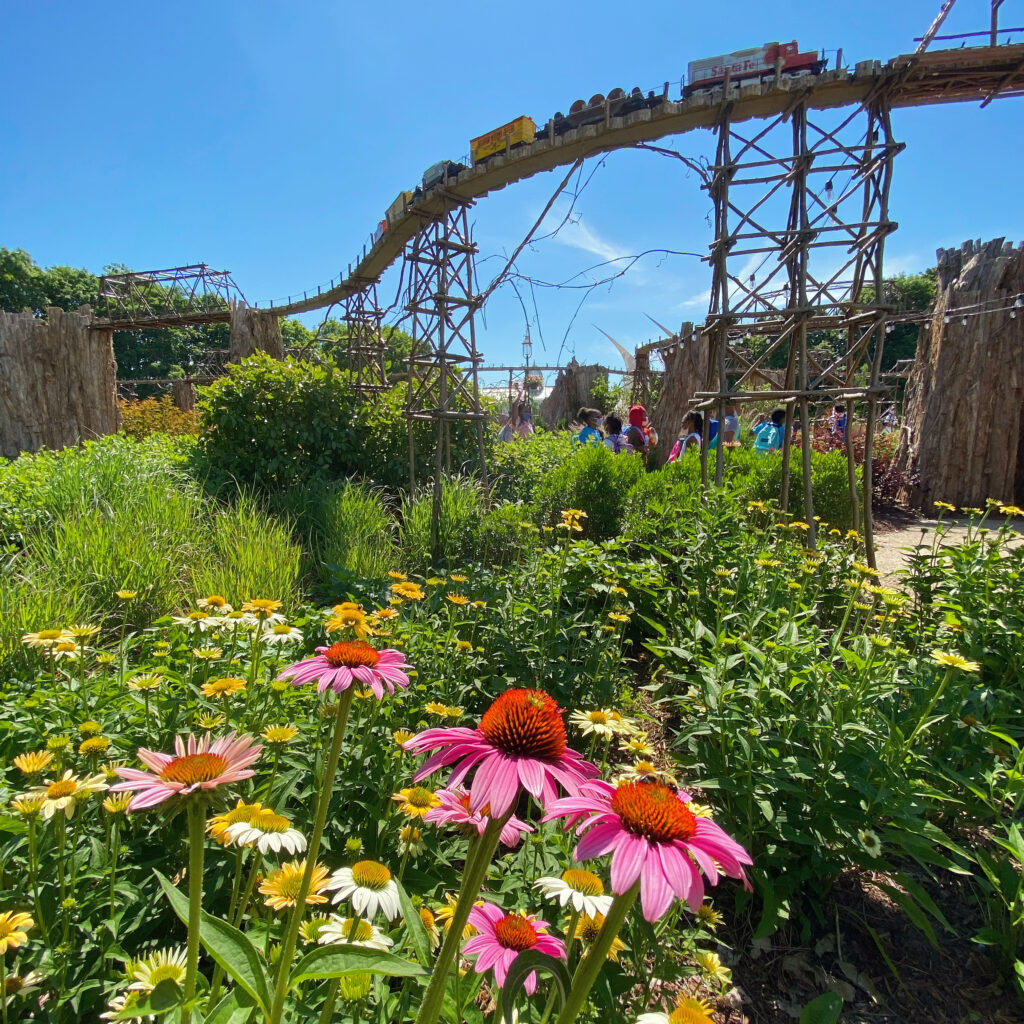 Paul Busse Garden Railway
Paul Busse Garden Railway
Deb and her late husband Donald were active members of the club. “When we first got married, we bought a starter train kit and laid it out in the backyard. It was more work than I thought,” Deb laughed. “That was our hobby we started together when we first got married, we really enjoyed doing it.” She especially enjoyed the bonsai-style gardening she would do around the tracks, planting dwarf conifers and “plants that nobody else has” in their garden railways from Mulberry Creek Herb Farm and Nursery.
After Donald passed away in January 2020, Deb came to the Conservatory to volunteer a lot more often. “It was my happy place that summer,” she recalls.
Deb’s generous spirit and the memory of her husband prompted her to make a $9,000 gift to help the Conservatory go from renting the exhibition to purchasing the garden railway as a permanent collection for the 2023 season and beyond. And she keeps volunteering as an ambassador, sharing her love of model trains and gardening with visitors young and old. Her favorite time? “I love to do evening hours because the sun is setting and the lights come on,” said Deb. “It’s a magical hour.”
Choose how you would like to give